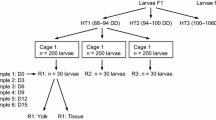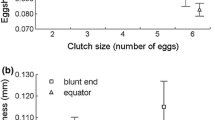Abstract
During the course of its embryonic development, the European lobster Homarus gammarus Linnaeus exhibits progressive increases in content of water (54.0 to 83.1%), ash (2.7 to 16.7%), protein (47.4 to 50.9%) and non-protein nitrogen (1.0 to 2.4%), and steady decreases in content of fat (43.8 to 25.4%) and energy (6343 to 5431 cal/g dry organic substance). Cumulative yolk utilization efficiency during the total development is 81.8% for dry weight; the corresponding value for energy is 60.1, for protein 75.6 and for fat 47.4%. Energy content of a single egg is 10.49 cal. Of 4.20 cal expended for metabolic processes of the embryo, only 13.3% energy is drawn from protein oxidation; fat oxidation supplies as much as 87.7% energy, that of carbohydrate only 2.3%. Embryonic development results in a remarkable decrease in net yolk utilization efficiency, which falls from 85.5% in the early developmental stages, to less than 70% in later developmental stages. The mean dry weight of a single egg membrane increases from 38 μg (2.2% of egg weight) in a freshly laid and attached egg, to 81 μg in an egg with an almost completely developed embryo. This result supports the earlier observation of Cheung (1966) that the formation of the inner chitinous egg membrane occurs after the egg is laid and attached to the setum. Protein seems to be the major constituent of the egg membrane (4049 cal/g dry weight), which has the following composition: protein 70.4%, non-protein nitrogen 0.13%, ash 2.83%. Initial permeability of the egg membrane to water (about 6% of the total water requirement is let in) is followed by a period during which the egg membrane is almost impermeable to water (stages I to III); the egg membrane becomes permeable to water again and lets in 85% of the total water requirement (the rest, i.e. 9%, is metabolic water) at a relatively advanced stage of development. These assumed changes in egg membrane permeability appear to be indicative of variations in the egg's osmoconcentration leading to shiftings in net transport of water. Rates of water and salt uptake during embryonic development are essentially parallel (Fig. 1). The egg membrane remains permeable to salts throughout development; salt intake almost doubles after the egg passes through stage III. A single egg, weighing 3.7 mg requires 4.9 mg water for successful completion of embryonic development. The imbibition of water by the developing marine demersal egg seems to (1) serve in osmotic hatching; (2) float the hatched larva by means of specific gravity reduction; (3) aid the larva to quickly adjust its body temperature. The simple osmotic hatching mechanism, proposed by previous workers, seems to be inadequate to account for the events and timing of the hatching process in the lobster. It is suggested that hatching time is determined not solely by increased internal pressure caused by inflow of water and salts, but also by some unknown internal factor. In the lobster egg, as well as in many other marine demersal eggs, protein metabolism is suppressed to a considerable extent, and fat metabolism is “geared up” Thus, the non-cleidoic lobster eggs exhibit metablic properties which are typical of cleidoic eggs. This finding is discussed in the light of Needham's (1950) concept of “cleidoicterrestrial and non cleidoic-aquatic eggs”.
Similar content being viewed by others
Literature cited
Allee, W. C. and K. P. Schmidt: Ecological animal geography, 2nd ed., 715 pp. New York: John Wiley & Sons 1957.
Appellöf, A.: Untersuchungen über den Hummer. Bergens Mus. Skr. (N.S.) 1, 1–79 (1909).
Baldwin, E.: An introduction to comparative biochemistry, 4th ed., 179 pp. Cambridge: University Press 1964.
Barnes, H.: Studies in the biochemistry of cirripede eggs. 1. Changes in the general biochemical composition during development of Balanus balanoides and B. balanus. J. mar. biol. Ass. U.K. 45, 321–339 (1965).
Burkenroad, M. D.: Reproductive activities of decapod crustacea. Am. Nat. 81, 392–398 (1947).
Cheung, T. S.: The development of egg-membranes and egg attachment in the shore crab Carcinus maenas and some related decapods. J. mar. biol. Ass. U.K. 46, 373–400 (1966).
Clarke, C. L.: Elements of ecology, 3rd ed., 560 pp. New York: Joh Wiley & Sons 1967.
Crisp, D. J.: A substance promoting hatching and liberation of young in cirripedes. Nature, Lond. 178, 263 (1956).
—: Studies on barnacle hatching substance. Comp. Biochem. Physiol. 30, 1037–1048 (1969).
— and C. P. Spencer: The control of the hatching process in barnacles. Proc. R. Soc. 148, 278–299 (1958).
Davis, C. C.: Osmotic hatching in the eggs of some fresh water copepods. Biol. Bull. mar. biol. Lab., Woods Hole 116, 15–29 (1959).
—: A study of the hatching process in aquatic invertebrates. 8. Events of eclosion in the American lobster Homarus americanus Milne-Edwards (Astacura, Homaridae). Am. Midl. Nat. 72, 203–210 (1964a).
—: A study of the hatching process in aquatic invertebrates. 9. Hatching within the brood sac of the ovoviviparous isopod Cirolina sp. (Isopoda, Cirolanidae). 10. Hatching in the fresh water shrimp Potimirim glabra Kingsley (Macrura, Atyidae). Pacif. Sci. 18, 378–384 (1964b).
Dunthorn, A. A.: Some observations on the behaviour and development of the Norway lobster. In: C. M. (Council Meeting) I.C.E.S. (International Counicil for the Exploration of the Sea) Sect. Shellfish and Benthos Committee K: 5, 1–11 (1967).
Figueiredo, M. J. e I. F. Barraca: Contribuicao para o conpecimento da pesca e da biologia do Lagostim (Nephrops norvecicus L.) na Costa Portuguesa. Notas Estud. Inst. Biol. mar., Lisb. 28, 1–45 (1963).
Flüchter, J. and T. J. Pandian: Rate and efficiency of yolk utilization in developing eggs of the sole ea solea. Helgoländer wiss. Meeresunters. 18, 53–60 (1968).
Gray, J.: The growth of fish. 1. The relationship between embryo and yolk in Salmo fario. J. exp. Biol. 4, 215–225 (1926).
—: The growth of fish. 2. The growth rate of the embryo of Salmo fario. J. exp. Biol. 6, 110–124 (1928).
Hayes, F. R.: The hatching mechanism of salmon eggs. J. exp. Zool. 89, 357–373 (1942).
Ivlev, V. S.: Energy balance of the growing larva of Siluris glanis. Dokl. Akad. Nauk SSSR 25, 87–89 (1939).
Kinne, O.: Irreversible nongenetic adaptation. Comp. Biochem. Physiol. 5, 265–282 (1962).
Kühn, R. und N. A. Sørensen: Über die Farbstoffe des Hummers (Astacus gammarus L.). Angew. Chem. 51, 465–468 (1938a).
—: Über Astaxanthin und Ovoverdin. Ber. dt. Chem. Ges. 71, 1879–1888 (1938b).
Lasker, R.: Efficiency and rate of yolk utilization by developing embryos and larvae of the Pacific sardine Sardinops caerulea (Giard). J. Fish. Res. Bd Can. 19, 867–875 (1962).
Marshall, S. M. and A. P. Orr: Hatching in Calanus finmarchicus and some other copepods. J. mar. biol. Ass. U.K. 33, 393–401 (1954).
Mengi, T.: Veränderungen in der chemischen Zusammensetzung des reifenden Ovariums des Ostseedorsches. Kieler Meeresforsch. 21, 107–121 (1965).
Needham, J.: Chemical embryology, 2021 pp. Cambridge: University Press 1931.
—: Biochemistry and morphogenesis, 785 pp. Cambridge: University Press 1950.
— and D. M. Needham: On phosphorus metabolism of embryonic life. 1. Invertebrate eggs. J. exp. Biol. 7, 317–348 (1930).
Paine, R. T.: Ash and calorie determinations of sponge and opisthobranchs tissues. Ecology 45, 384–387 (1964).
Pandian, T. J.: Changes in chemical composition and caloric content of developing eggs of the shrimp Crangon crangon. Helgoländer wiss. Meeresunters. 16, 216–224 (1967).
—: Yolk utilization in the gastropod Crepidula jornicata. Mar. Biol. 3, 117–121 (1969).
Pandian, T. J. Yolk utilization and hatching time in the Canadian lobster Homarus americanus. (1970a) (unpublished).
Pandian, T. J. Egg incubation and yolk utilization in the isopod Ligia oceanica. Proc. natn. Inst. Sci. India (1970b). (In press).
Pandian, T. J. Studies on chitin synthesis in developing embryos of some crustacean eggs. (1970c) (unpublished).
Pandian, T. J. Cleidoic properties of marine demersal eggs. (1970d; communicated to Indian J. exp. Biol.).
— and K.-H. Schumann: Chemical composition and caloric content of egg and zoea of the hermit crab Eupagurus bernhardus. Helgoländer wiss. Meeresunters. 16, 225–230 (1967).
Prosser, C. L. and F. A. Brown: Comparative animal physiology, 2nd ed., 688 pp. Philadelphia: W. B. Saunders Co. 1962.
Ramult, M.: Untersuchugen über die Cladoceren-Fauna des polnischen Ostseeküsten-Landes. Bull. int. Acad. pol. Sci. Lett. (Cl. Sci. math. nat.) 2, 311 (1930).
Ranzi, S.: L'accrescimento dell embrione dei cefalopodi (Recerche sugli scambi tra ovo ed ambiente). Arch. f. EntwMech. Org. 121, 345–365 (1930).
Richards, A. G.: The integument of arthropods: the chemical components and their properties, the anatomy and development and the permeability, 411 pp. Minneapolis: University of Minnesota Press 1951.
Roth, H.: Quantitative organische Mikroanalyse, 7. Aufl., 361 pp. Wien: Springer 1958.
Le Roux, M. L.: Recherches sur la sexualité des Gammariens. Croissance, reproduction, déterminisme des caractères sexuels secondaires. Bull. biol. Fr. Belg. (Suppl.) 16, 1–138 (1933).
Shinozaki, J.: The specific heat of insects. J. Fac. Sci. Hokkaido Univ. (Zool.) 13, 470–474 (1957).
Smith, S.: Early development and hatching. In: sed The physiology of fishes, Vol. 1, pp 323–360. Ed. by M. E. Brown. New York: Academic Press 1957.
Stern, K. G. and K. Salomon: On ovoverdin, the carotenoid-protein pigment of the egg of the lobster. J. biol. Chem. 122, 461–475 (1938).
Stolfi, G.: L'accrescimento embrionale del Loligo vulgaris. Atti. Accad. naz. Lincei Rc. (Cl. Sci. fis. mat. nat.) 18, 516 (1933).
Yonge, C. M.: The nature and significance of the membranes surrounding the developing eggs of Homarus vulgaris and other Decapoda. Proc. zool. Soc. Lond. 107, 499–517 (1937).
—: Permeability and properties of the egg membranes surrounding the developing egg of Homarus vulgaris. J. mar. biol. Ass. U.K. 26, 432–438 (1946).
—: Egg attachment in Crangon vulgaris and other Caridea. Proc. R. Soc. Edinb. 65, 369–400 (1955).
Author information
Authors and Affiliations
Additional information
Communicated by N. K. Panikkar, Panaji, and O. Kinne, Hamburg
Dedicated to Professor P. Kochukutta Menon, Montreal, on his 62nd birthday, June 3, 1970.
Rights and permissions
About this article
Cite this article
Pandian, T.J. Ecophysiological studies on the developing eggs and embryos of the European lobster Homarus gammarus . Marine Biology 5, 154–167 (1970). https://doi.org/10.1007/BF00352599
Accepted:
Issue Date:
DOI: https://doi.org/10.1007/BF00352599




